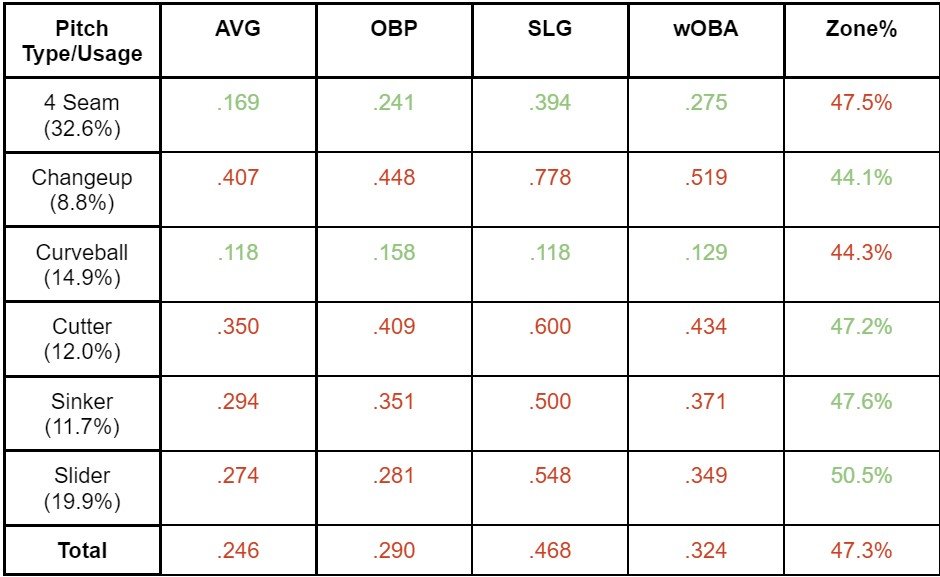This was initially supposed to be part of a free agent steals article, but as I found myself getting more and more fascinated with Taillon, I ended up writing way too much to fit into the original.
Jameson Taillon was once viewed as a highly talented pitcher with legitimate ace potential. Today, Taillon is heading into the free agent market off back-to-back seasons with ERA- marks at, or below average. While he hasn’t performed to the level he was once widely viewed as capable of reaching, I still see massive upside in Taillon.
Arsenal and Tunneling
Models don’t love Jameson Taillon’s repertoire (97 Stuff+ in 2022), but that doesn’t tell the entire story. He has slightly above average velocity on his 4 Seam at 94.1 MPH, and makes it appear even faster with an above average 6.6 feet of extension. The offering gets an above average 17.8 inches of induced vertical break, but an unimpressive 6.08 foot vertical release creates an unremarkable vertical angle on the pitch. It’s certainly not bad, but nothing game changing.
The reason for Taillon’s upside, rather than raw stuff across the board, is how his secondaries tunnel (read more about tunneling here) off of the fastball, as well as off of one another. Taillon’s Slider is separated from the 4 Seam by 13.7 inches of IVB, 11.9 inches of horizontal break, and 7.9 MPH. His hard Curve is separated from the Slider by 14.2” IVB, 3” HB, and 5.1 MPH. The result of this 3-pitch interaction is a Slider and Curveball that both draw chases because, out of his hand, batters are often tricked into believing that it’s a different pitch hung down the middle. His Curveball, because of its movement, also gets very few swings in the strike zone. When it does, it rarely gets punished because it has elite stuff.
On the other side of Jameson Taillon’s arsenal, despite an abhorrent 14.6” IVB, his sinker generates a 61.8% GB rate vs same-handed batters. The reason for this, perhaps surprising, outcome is because it kills 3.2 inches of vertical break off of the heater, running below the bats of hitters who are attempting to lift a 4 Seam. It’s by no means an amazing offering, but it can be a very useful pitch against righties with flat swing paths, as well as in double play scenarios. His changeup, however, has too little separation to do much of anything in the way of effectiveness against opposite-handed (or same-handed) batters. It has little-to-no usefulness, with the curveball essentially doing its job except better. This is not to say that the changeup should be completely dropped, but it’s the least effective pitch in Taillon’s repertoire.
Underperforming Outlier
Among the 6 pitches in his arsenal, Jameson Taillon throws one that is a complete outlier. Taillon’s cutter has 12.5 inches of induced vertical break at 90.7 MPH. For perspective, there are only 4 major league pitchers (min. 50 pitches) who simultaneously throw their cutters with more vertical break and velocity. Of those four, one cutter (Merrill Kelly’s) moves armside. The other three are relievers in David Robertson, Kenley Jansen, and Rowan Wick; two of them have less horizontal break and the other, Jansen, has a career ERA of 2.46, being one of the more dominant closers in baseball history all while using his cutter 80.5% of the time.
This is an obscenely good pitch in terms of the break and velocity combo, and the specs encourage sheer dominance against batters of the opposite handedness. That said, it hasn’t exactly played as an elite pitch (.322 wOBA/0 RV). While the lack of success is partially the result of it being similar to the fastball, that shouldn’t necessarily stop it from performing, as it does work well alongside the slider and curve.
Taillon’s cutter fails more than it should against opposite-handed batters for two primary reasons. First is that it’s thrown too high. A pitch that has similar velocity to the four-seam, but with 5.2 fewer inches of IVB, while running in on the hands, has extreme groundball potential. However, Taillon’s cutter only yields groundballs at a 40.7% clip (the 11.1% line drive and 29.6% popup rates are incredible, however). This isn’t because of some movement quirk, but rather because he throws it at an average height of 2.69 feet. That is near the 2.74’ height of the league average four-seam. If Taillon threw it at the same 2.35’ height as the league average cutter, the groundball rate would skyrocket.
The second big reason for Taillon’s FC struggles can be attributed to his horizontal release not being optimized in favor of the offering. The horizontal angle of a pitch flattens or steepens depending on a pitcher’s horizontal release, and rubber positioning can often be an easy way of improving upon a pitch’s angles.
Taillon Mound Positioning, Centerfield View
Taillon’s FC averages a -1.45 foot horizontal release. With a change in mound positioning, his horizontal release point could go up to over 2 feet, making the pitch much more likely to jam lefties. Taillon would then be able to work his other breakers off of a cutter primary, in turn dominating opposite-handed matchups. Blake Treinen, Evan Phillips, Shohei Ohtani, and Clayton Kershaw are a few pitchers who currently use fastballs with steep inwards angles to dominate opposite-handed matchups. He wouldn’t even need to change the pitch’s vertical location, as either high or low would yield more popups or grounders respectively.
Side Note: Even before he threw a cutter, Taillon hugged the 3rd base side of the rubber in Pittsburgh. With the Pirates, Taillon had an 89 ERA- and 85 FIP- compared to 101 in both of the two stats with New York.
The Real Culprit
The answer to Taillon’s struggles is not Yankee Stadium. While in the Bronx, Taillon sported a 3.27 ERA in 2021 and 3.47 ERA in 2022, with 5.60/4.36 ERA’s on the road in each of those years respectively. He was not only not worse at home–he actually performed far better! Rather, the problem with Taillon is how he utilizes his repertoire. This is best exemplified by his FIP, which rises from 3.40 with bases empty to 4.80 with runners on. This 1.4 point rise in FIP is nearly 5 times the league average of 0.29 (3.84 to 4.13).
Below, I have highlighted Jameson Taillon’s performance with bases empty, as well as with runners on base:
Jameson Taillon With Bases Empty
Jameson Taillon With Runners on Base
Jameson Taillon’s arsenal, without fail, performed better across the board with runners on when he threw a pitch in the zone less often. His pitches, also without fail, performed worse across the board when Taillon upped the zone percentage. The reason for this is that batters are inherently more aggressive with runners on (broken down here). When the bases are empty, Taillon’s OBP-killing strategy proves to be very valuable, but it loses a lot of effectiveness when hitters are able to capitalize on the slugging risk with runners on. Taillon gave up home runs almost twice as often when runners were on base.
The solution to his runners on woes is to simply utilize tunnels and throw fewer strikes with those pitches with upped zone usage. Even if Taillon’s walk rate goes up with runners on, it’s a more-than-worthwhile trade to avoid unfavorable batted balls and potential extra-base hits.
Fun Fact: With runners on in 2022, Jameson Taillon’s Curveball (14.9% usage) did not allow a single extra base hit.
Return On Investment
Jameson Taillon offers a deep repertoire with various tunnels, as well as the command to capitalize on an optimized pitching strategy. Furthermore, Taillon’s Curveball specs and accommodating pitch movement pose the question of whether an additional offering, such as a Sweeper, would be a possible addition to his arsenal. He is not a simple plug-and-play starter who will equally reward whichever team he ends up on. Rather, Jameson Taillon is a potential steal for teams that know how to play to his strengths accordingly. If Taillon lands in the correct organization, he can become a high level contributor.




